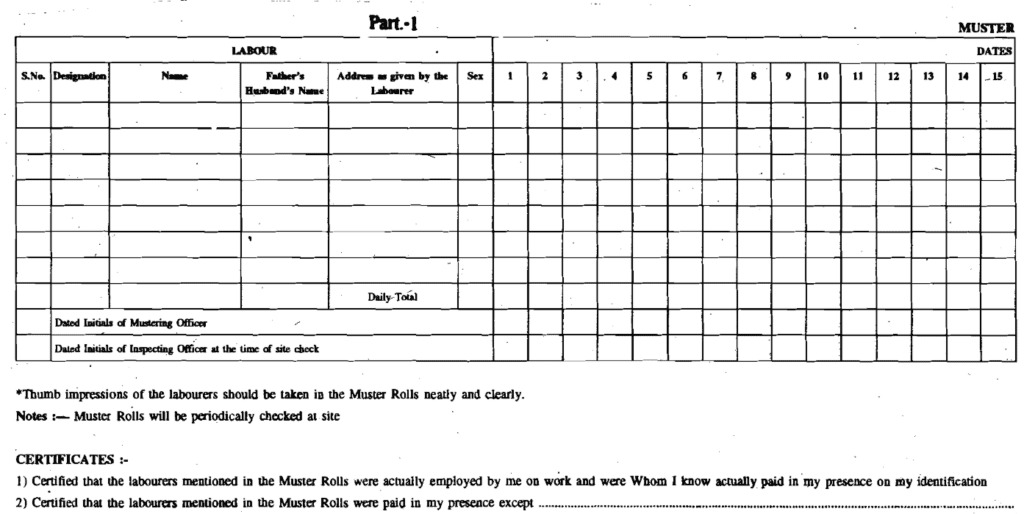Construction works, maintenance works or any other works may be executed departmentally by employing daily labour, such as masons, carpenters, plumbers, etc. The attendance of these labourers is kept in Muster Roll by the supervisor or manager of the authorized.
Muster Roll (M.R.)
In the construction industry, a muster roll is a document used to track the attendance of workers on a construction site. It typically includes details such as the names of workers, their trade or job classification, hours worked, days present, and any other relevant information related to their presence on the site.
M.R. help construction managers or supervisors monitor workforce attendance, track labour costs, and ensure compliance with labour regulations and safety standards. They are often maintained by government agencies or regulatory bodies overseeing construction projects.
The Muster Roll consists of three parts:
- Part -1 (Nominal Roll)
- Part -2 (Register of arrears of wages due to worked people)
- Part -3 (Details of measurement of work done by labour)
Part -1 (Nominal Roll)
Part-1 of muster roll also known as Nominal Roll is a record or document where the daily attendance of labourers is recorded. In this part, there are columns and spaces for the names of the labourer, designation, father’s name, dates of attendance, rates, the total amount due for each, the total amount due for the whole, the signature of the person taking attendance, the signature of the officer making payment, etc. and these columns are duly filled up. Fines if inflicted on the labourer are recorded in Part -1. M.R. should never be made in duplicate and entries should be made with ink so that it may not be possible to interpolate or alter them.
The names of the labourers are grouped according to classes as masons, carpenters, etc.
In India, Form 21 is used as a muster roll for part 1.

Part -2 (Register of arrears of wages due to worked people)
Part 2, is the form which is a register of areas of unpaid wages brought forward. This form contains the rows and space for the name of the labour, the father’s name, the amount due and the amount paid to him.
In India, Form 28 is used as a muster roll.

Part -3 (Details of measurement of work done by labour)
Part 3 is the form where the completed and progress of ongoing tasks are documented. Detail measurements are recorded in the measurement book, and a breakdown of quantities is compiled under specific subheadings. This abstract of quantities is then noted in Part 3 of the muster roll, referencing the corresponding entries in the measurement book. If any aspect of the work cannot be measured, a note indicating this is included in the same section.
Also, read: Measurement Book: 5 Ultimate Guide to use MB.
Rules for Preparation of Muster Roll
The Muster Roll is prepared and detailed in accordance with the following rules:
- Multiple Muster rolls may be maintained for each project, but they must be prepared in duplicate. It is acceptable to consolidate the records into one M.R. for labourers engaged across several small works nearby.
- Labourers may receive payments more frequently than once a month, but a new Muster roll should not be generated for each payment cycle.
- Daily attendance, absences, and any fines imposed on labourers must be meticulously recorded in ink within the M.R. This ensures accurate calculations and safeguards against tampering with attendance records and cost classifications, which are to be kept separate for works and their respective subheads.
- Upon approval of an M.R., prompt payment should be facilitated, with each payment initiated and dated by the designated paying officer. Any outstanding payments should be duly noted in the Register of Unpaid Wages.
- Unpaid wages are deposited into the cash fund and held as a deposit, with provisions for subsequent payment detailed in Hand Receipt -Form 28, duly signed. A record of such payments is entered into the Register of Unpaid Wages, updating the original entry accordingly.
FAQs:
Q: Which form is used for muster roll?
Answer: Form 21 is used for muster roll which contains columns and spaces for the names of the labourer, designation, father’s name, dates of attendance, rates, the total amount due for each, the total amount due for the whole, the signature of the person taking attendance, the signature of the officer making payment, etc. and these columns are duly filled up.
Q: What are the differences between the muster roll and the attendance register?
Answer: Muster rolls and attendance registers serve similar purposes in tracking attendance but differ in their formats and usage.
The muster roll contains columns and space for detailed information about each individual, including their name, rank or designation, duties assigned, and other relevant details. However, the attendance register contains columns for names and dates and is primarily used for basic attendance tracking purposes, without necessarily including detailed information about individuals’ roles or responsibilities.
References:
- Dutta, B. N. (2007). Estimating and Costing in Civil Engineering (26th ed.). UBS Publishers’ Distributors Pvt. Ltd.
- Team, D. C. (2022, March 3). The complete guide to muster Roll – All you need to know. Deskera Blog. https://www.deskera.com/blog/guide-to-muster-roll/
![]()







